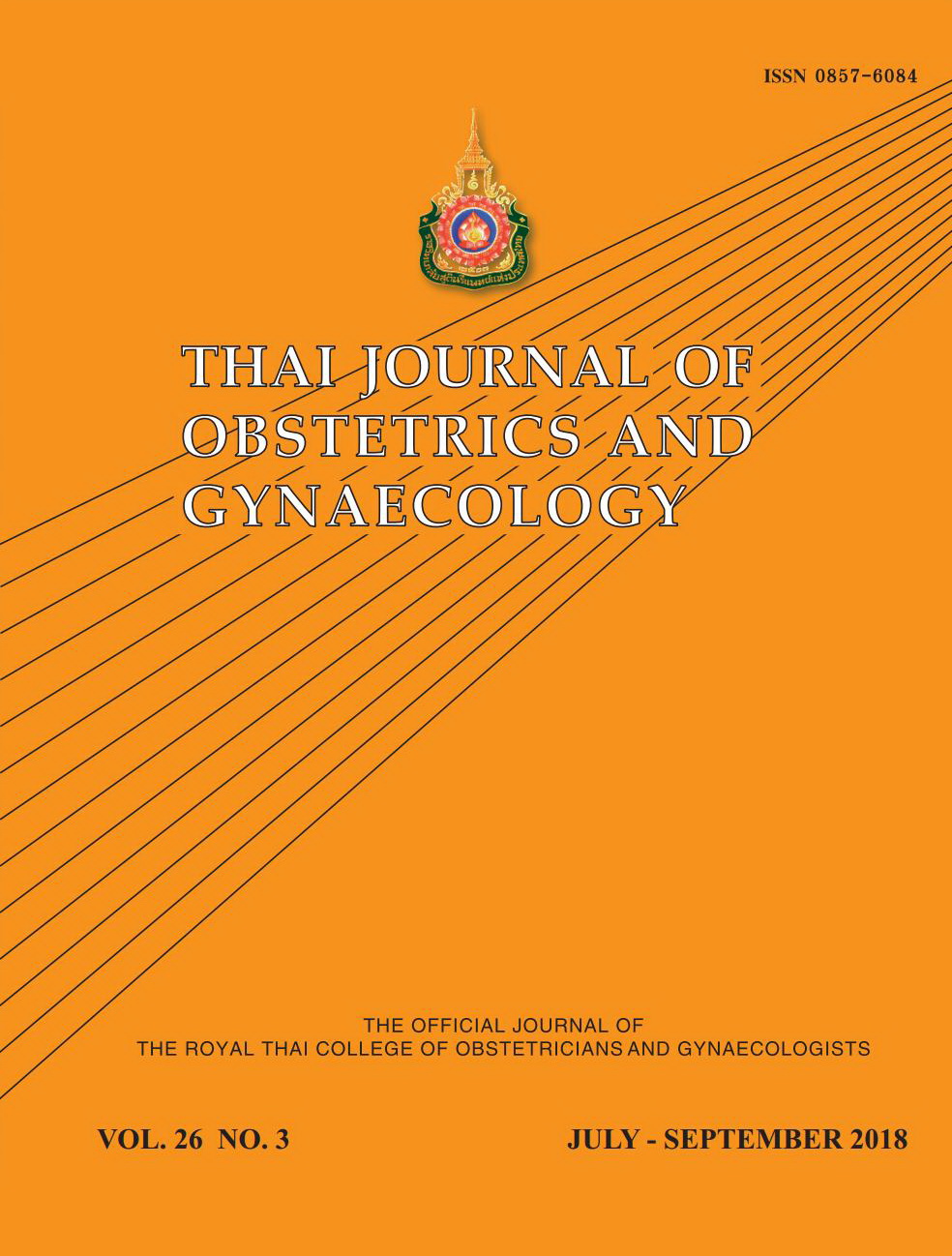Estimating the Date of Confinement: A 3-year retrospective study in Ramathibodi Hospital
Main Article Content
Abstract
Objective: To estimate limits of agreement (LOA) between the actual date of delivery (ADD) and four different methods for estimated date of confinement (EDC) based on last menstrual period (LMP).
Materials & Methods: This retrospective cross-sectional study was conducted in the pregnant women who delivered at Ramathibodi Hospital, Bangkok, Thailand during 2013 – 2015. The inclusion criteria were term pregnancy, singleton, spontaneous onset of labor, certain date and duration of LMP, regular menstrual cycles, no recent use of hormonal contraceptives in past 3 months, ultrasound scan in mid-trimester was performed and all newborns were evaluated full-term by pediatricians. Exclusion criteria was wrong date recalled after redating with ultrasound scan in mid-trimester. Four methods for EDC: Naegele’s rule using the 1st day of LMP, Naegele’s rule using last day of LMP, pregnancy wheel, and pregnancy calculator application were compared with ADD. The discrepancies between EDC and ADD were defined as the LOA and its 95% confidence interval (95%CI). Statistical comparison was performed by using Bland and Altman’s method.
Results: There were 1,883 pregnant women who met the criteria. LOA of ADD was 5.2 days before predicted EDC by pregnancy calculator application. Predicted EDC using last day of LMP by Naegele’s rule was differ from LOA of ADD more than other methods (-8.8 days). Different days in each month affect predicted EDC except by application method.
Conclusion: Pregnancy calculator application based on LMP is the preferred method for predicting EDC when compared with Naegele’s rule and pregnancy wheel in women who can certainly remember her LMP.
Keywords: EDC, Estimated date of delivery, Naegele’s rule, pregnancy wheel, pregnancy calculator application
Article Details
References
2. American College of Obstetricians and Gynecologists. Method for estimating due date. Committee Opinion No. 611. Obstet Gynecol 2014; 124: 863-6.
3. American College of Obstetricians and Gynecologists. Management of suboptimally dated pregnancies. Committee Opinion No. 688. Obstet Gynecol 2017; 129: 591-2.
4. Nguyen TH, Larsen T, Engholm G, MØller H. Evaluation of ultrasound-estimated date of delivery in 17,450 spontaneous singleton births: do we need to modify Naegele’s rule?. Ultrasound Obstet Gynecol 1999; 14: 23-8.
5. BergsjØ P, Denman DW, Hoffman HJ, Meirik O. Duration of human singleton pregnancy – a population-based study. Acta Obstet Gynaecol Scand 1990; 69: 197-207.
6. Baskett TF, Nagele F. Naegele’s rule: a reappraisal. Br J Obstet Gynaecol 2000; 107:
1433-5.
7. Loytved CAL, Fleming V. Naegele’s rule revisited. Sex Reprod Healthc 2016; 8:
100-1.
8. Bedford GS. The Principles and Practice of Obstetrics. 5th Edition. New York: William Wood and Co, 1872: 306.
9. Williams JW. Obstetrics. New York: D. Appleton & Co, 1903: 171-4.
10. Chyjek K, Farag S, Chen KT. Rating pregnancy wheel applications using the APPLICATIONS Scoring System. Obstet Gynecol 2015; 125: 1478-83.
11. ACOG reinvents the pregnancy wheel. American College of Obstetricians and Gynecologists [Internet]. 2016 [cited 2016 Jan 22] Available from: https://m.acog.org/About-ACOG/News-Room/News-Releases/2016/ACOG-Reinvents-the-Pregnancy-Wheel?IsMobileSet=true
12. Bland JM, Altman DG. Statistical methods for assessing agreement between two methods of clinical measurement. Lancet. 1986; 1(8476): 307-10.
13. Bland JM, Altman DG. Applying the right statistics: analyses of measurement studies. Ultrasound Obstet Gynecol. 2003; 22(1): 85-93.
14. Backe B, Nakling J. Term prediction in routine ultrasound practice. Acta Obstet Gynaecol Scand 1994; 73: 113-8.
15. Olsen O, Aaroe Clausen J. Routine ultrasound dating has not been shown to be more accurate than the calendar method. Br J Obstet Gynaecol 1997; 107: 1221-2.
16. Ross MG. Circle of time: errors in the use of the pregnancy wheel. J Matern Fetal Neonatal Med 2003; 14: 370-2.
17. McParland P, Johnson H. Time to reinvent the wheel. Br J Obstet Gynaecol 1993; 100:
1061-2.
18. Hutchon DJ, Kearney C. Clinical interpretation of ultrasound biometry for dating and for assessment of fetal growth using a wheel and chart: is it sufficiently accurate? Ultrasound Obstet Gynecol 1999; 13: 103-6.
19. Chambliss LR, Clark SL. Paper gestational age wheels are generally inaccurate. Am J Obstet Gynecol 2014; 210: 145. e1-4.
20. Mackenzie AP, Stephenson CD, Funai EF. Prenatal assessment of gestational age and estimated date of delivery. Uptodate [Internet]. 2016 [cited 2016 Apr 8] Available from: https://www.uptodate.com/contents/prenatal-assessment-of-gestational-age-and-estimated-date-of-delivery

